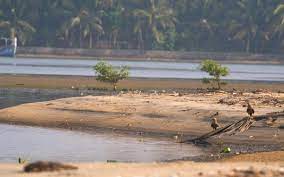Kadalundi Mudflat : Shrinking

The mudflat ecosystem in Kadalundi, located on the southwest coast of India, is shrinking rapidly due to natural and anthropogenic factors, with sand sedimentation covering the once-abundant inter-tidal mudflats.
- In the early 2000s, Kadalundi had approximately 8 hectares of nutrient-rich mudflats, but now it has dwindled to just about 1 hectare.
- The mudflats provide essential prey, such as polychaetes and crustaceans, attracting a diverse range of migratory birds from places like Siberia, Ladakh, Mongolia, and Scotland
- Mudflats, also known as tidal flats, are coastal wetlands that form when tides or rivers deposit mud. They are found in sheltered areas such as bays, bayous, lagoons, and estuaries.




